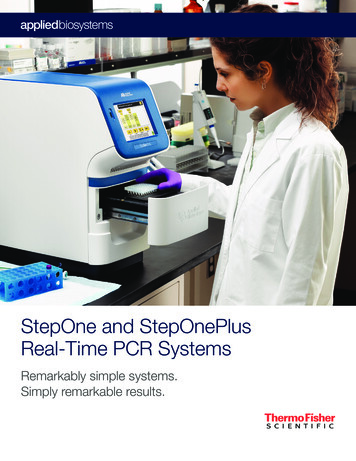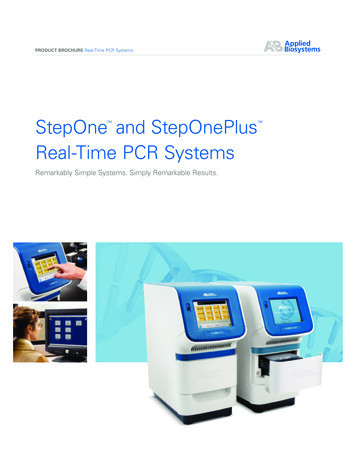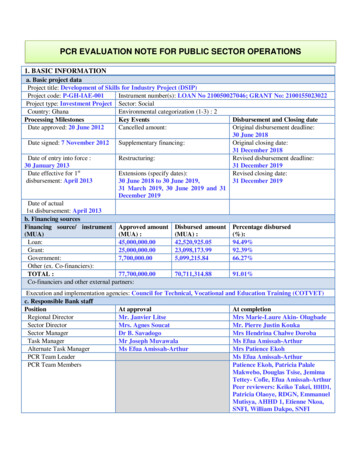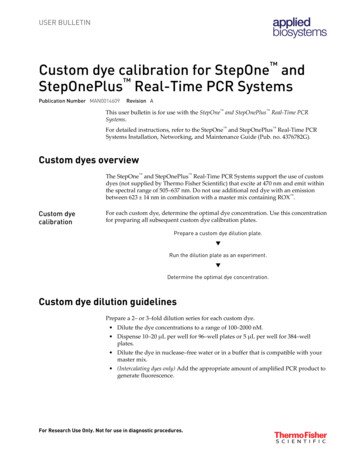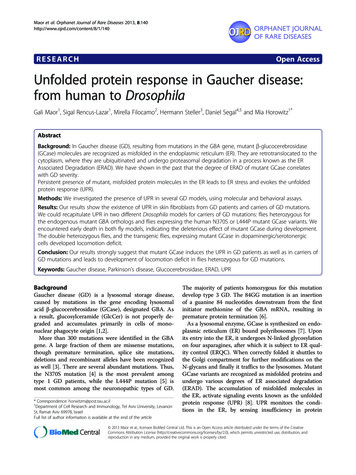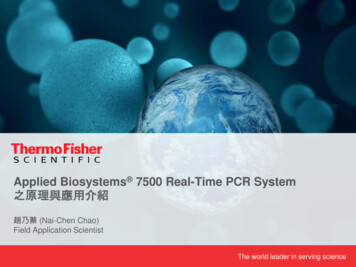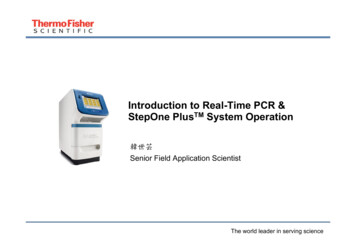
Transcription
EVALUATION OF CHROMAGAR AND PCR FOR DETECTIONOF METHICILLIN RESISTANT STAPHYLOCOCCUS AUREUS(MRSA) FROM CLINICAL ISOLATESDissertation submitted in partial fulfillment of theRequirement for the award of the Degree ofM.D. MICROBIOLOGY(BRANCH IV)DEPARTMENT OF MICROBIOLOGYTIRUNELVELI MEDICAL COLLEGE,TIRUNELVELI - 627011.THE TAMILNADUDR.M.G.R.MEDICAL UNIVERSITY,CHENNAI.APRIL 2013.
CERTIFICATEThis is to certify that the dissertation entitled, ‘‘Evaluation ofChromagar and PCR for detection of Methicillin lates”byDr.T.Susitha, Post graduate in Microbiology (2010-2013), is a bonafideresearch work carried out under our direct supervision and guidance andis submitted to The Tamilnadu Dr. M.G.R. Medical University, Chennai,for M.D. Degree Examination in Microbiology, Branch IV, to be held inApril 2013.GUIDE: (Dr. N. Palaniappan,M.D)Professor and Head,Department of Microbiology,Tirunelveli Medical College,Tirunelveli –11.
CERTIFICATEThis is to certify that the Dissertationtitled ‘‘Evaluation ofChromagar and PCR for detection of Methicillin ResistantStaphylococcus aureus (MRSA) from clinical isolates”presentedherein by Dr.T.Susitha , is an original work done in the Department ofMicrobiology, Tirunelveli Medical College Hospital, Tirunelveli for theaward of Degree of M.D. (Branch IV) Microbiology under my guidanceand supervision during the academic period of 2010 - 2013.The DEANTirunelveli Medical College,Tirunelveli - 627011.
DECLARATIONI solemnly declare that the dissertation titled “Evaluation ofChromagar and PCR for detection of Methicillin ResistantStaphylococcus aureus (MRSA) from clinical isolates” is done by me atTirunelveli Medical College hospital, Tirunelveli.The dissertation is submitted to The Tamilnadu Dr. M.G.R.MedicalUniversity towards the partial fulfilment of requirements for the award ofM.D. Degree (Branch IV) in Microbiology.Place: TirunelveliDr. T.SusithaDate:Postgraduate Student,M.D Microbiology,Department of Microbiology,Tirunelveli Medical CollegeTirunelveli.
Acknowledgement
ACKNOWLEDGEMENTI sincerely express my heartful gratitude to the Dean, TirunelveliMedical College, Tirunelveli for all the facilities provided for the study.I take this opportunity to express my profound gratitude toDr.N. Palaniappan, M.D., Professor and Head, Department ofMicrobiology, Tirunelveli Medical College, whose kindness, guidanceand constant encouragement enabled me to complete this study.I am deeply indebted to Dr. S. Poongodi@ Lakshmi, M.D.,Professor, Department of Microbiology, Tirunelveli Medical College,who helped me to sharpen my critical perceptions by offering mosthelpful suggestions and corrective comments.I am very grateful to Dr.C.Revathy,M.D., Professor, Department ofMicrobiology, Tirunelveli Medical College, for the constant supportrendered throughout the period of study and encouragement in everystage of this work.I wish to thank Dr. V.Ramesh Babu, M.D., Professor ,Department ofMicrobiology, Tirunelveli Medical College, for his valuable guidance forthe study.I am highly obliged to Dr.B.Cinthujah, M.D.,Senior AssistantProfessor, Dr. G.Velvizhi, M.D., Dr. G.Sucila Thangam, M.D, Dr V.PAmudha M.D., Dr I.M Regitha M.D., Assistant Professors, Department
of Microbiology, Tirunelveli Medical College, for their evincing keeninterest, encouragement, and corrective comments during the ,andDR.T.Jeyamurugan ,M.D., Senior Assistant Professors, Department ofMicrobiology, Tirunelveli Medical College for their help andencouragement at the initial stage of my work.Special thanks are due to my co-postgraduate colleaguesDr.G.Manjula, Dr.S.Nirmaladevi, Dr.A.Anupriya and Dr. Chitra fornever hesitating to lend a helping hand throughout the study.I would also wish to thank my junior post-graduate colleagues,Dr.S.Suganya, Dr. K.Girija, Dr. J.Senthilkumar, Dr.J.K.Jeyabharathi,Dr.J.Jeyadeepana, Dr.V.G. Sridevi, Dr.R.Nagalakshmi, Dr.C.Meenakshi,and Dr.A.Uma maheswari for their help and support.Thanks are due to the, Messer V.Parthasarathy, V.Chandran,S.Pannerselvam, S.Santhi, S.Venkateshwari. M.Mali, S.Arifal ivannan,K.Umayavel, Sreelakshmi and other supporting staffs for their servicesrendered.I thank Mr. Arumugam, who helped me in the statistical analysisof the data.
I am indebted to my husband Er.C.Berin Jones, parentsMr.C.Thankian and Mrs.C.Paulmathi, brother Er.T.Vinod and my sonEdriick B. Christonson not only for their moral support but also fortolerating my dereliction of duty during the period of my study.And of course, I thank the Almighty for His presence throughoutmy work. Without the Grace of God nothing would have been possible.
Contents
CONTENTSS.NoChapterPage No.1.Introduction12.Aim and Objectives173.Review of literature194.Materials and clusion909.Bibliography10.Annexure – I (Media preparation)11.Annexure – II (Proforma of the Data sheet)12.Annexure – III (Master chart)
Introduction1
1. INTRODUCTIONThe emergence of antibiotic resistance is a health problemworldwide and has affected the management and outcome of widespectrum of infections. It contributes to significant mortality andmorbidity and remains a hinderance to the control of infectious diseases.It leads to increase in health associated expenses and also acts as a barrierin the healthcare security of countries.1 Now-a-days, the need for newerantibiotics to treat infections caused by Gram positive organisms is beingincreasingly felt.Globally, Staphylococcus aureus (S.aureus) is considered as one ofthe most common cause of nosocomial infections. This remains as thehardiest of the non-sporing bacteria and can survive well in theenvironment under both moist and dry conditions. The high prevalence ofS.aureus, together with its propensity to infiltrate tissues, colonize foreignbody material, form abscesses and produce toxins, makes it by far themost feared micro-organism in healthcare-associated infections.In recent times, there is a steady rise in the number of S.aureusisolates that show resistance to Methicillin and has evolved as a seriousproblem since resistance to this drug indicates resistance to all β-lactamantibiotics. Multiple use of antibiotics and prolonged hospitalisation areimportant factors which make hospital an ideal place for transmission andperpetuation of Methicillin Resistant S.aureus (MRSA).2 For these above2
reasons, accuracy and promptness in the detection of Methicillinresistance plays a key role for good prognosis of infections and henceabrupting its transmission.31.1. Historical importanceSir Alexander Ogston, a Scottish surgeon in 1880, showed that anumber of human pyogenic diseases were associated with a clusterforming micro-organism and introduced the name ‘Staphylococcus’. InGreek, ‘staphyle’ means bunch of grapes and ‘kokkos’ means berry. VonDaranyi, in 1925 was the person to identify the coagulase test forS.aureus.41.2. MorphologyStaphylococci are placed in the family Bacillaceae of the orderBacillales. S.aureus is a Gram positive, uniformly spherical cocci of0.5µm to 1.5µm in diameter on light microscopy and tends to occur inirregular grape-like clusters and less often, singly, pairs, tetrads, and shortchains. This is due to the incomplete cell division in three perpendicularplanes. In liquid media, singles, pairs and short chains are also seen. Theyare facultative anaerobes, nonmotile, non-sporing, and catalase positive.51.3. Cultural characteristicsColonies of S.aureus are medium to large, smooth, low convex,entire, glistening, densely opaque and of butyrous consistency and areβ- hemolytic on sheep blood agar at 37 C when incubated for 18- 243
hours. The colonies of S.aureus are usually deep golden yellow (aureusmeans golden) and pigmentation can be enhanced on fatty media such asTween agar, by prolonged incubation and at room temperature. OnMannitol salt agar it forms 1mm diameter yellow colonies surrounded byyellow medium due to acid formation.51.4. Biochemical reactionsS.aureus ferments a range of sugars of which the significant one ismannitol. Acetoin production, gelatinase and alkaline phosphatase are alltypically positive. Indole is negative while urease and lactosefermentation are variable characters. It produces a deoxyribonuclease anda thermonuclease.5 S.aureus gives a positive test for bound coagulase(clumping factor). It produces free coagulase which clots plasma byconverting fibrinogen to fibrin and this property is used as a criterion inclinical laboratories to diagnose pathogenic S.aureus.1.5. HabitatS.aureus is found in the anterior nares of 20-40% of the adults andalso in the intertriginous skin folds, the perineum, the axilla and thevagina.6Decreased ciliary action and attachment to cell associated andcell free secretions favour its adhesion to nose.74
1.6. PathogenesisThe bacterium can form biofilms, the tool which helps in theinvasion of the defense mechanisms. The microcapsule of this bacteriumhas ‘zwitterionic’ characters and also paves way for formation ofabscess.8The protein A of S.aureus attaches to the Fc portion nhibited. S.aureus produces leukocidins which leads to the production ofpores in the cell membrane and hence lysis of the leukocyte.9During infection, enormous enzymes are released, such asproteases, lipases and elastases which directs its progression to ultimatedestruction. Some isolates produce superantigens, which produces“cytokine storm”, resulting in food poisoning, scalded skin and toxicshock syndrome.101.7. Mode of transmissionNasal carriers of S.aureus have a three to six time’s higher risk ofnosocomial infection than non-carriers.11 S.aureus is transmitted fromperson to person by direct contact, fomites, air or unwashed hands ofhealth care workers in nosocomial setting. Respiratory droplets and skinsquames released from the patients are other possible mechanisms forMRSA transmission in hospitals.12 When newborns are colonized bythese organisms, the nursing mothers are at risk of developing mastitis.135
1.8. InfectionsS.aureus may cause a variety of infections ranging from mild tolife-threatening serious illnesses. Infections generally involve intensesuppuration and necrosis of tissue. This organism is frequently isolatedfrom postsurgical wound infections.6 S.aureus can be recovered fromalmost any clinical specimen. The infections14 caused by this organismare as follows:Skin and soft tissue- Impetigo, boils, carbuncles, abscesses,cellulitis, fasciitis, pyomyositis, surgical and traumatic woundinfections.Foreign body associated- Intravascular catheter, urinary catheter,surgical implant, endotracheal bophlebitis,infective endocarditis.Bone and joints- Septic osteomyelitis, septic arthritis.Respiratory -Pneumonia, empyema, sinusitis, otitis media.Other invasive infections- Meningitis, surgical space infection.Toxin mediated diseases- Staphylococcal toxic shock syndrome,food poisoning, staphylococcal scalded skin syndrome, bullousimpetigo, necrotizing pneumonia, necrotising osteomyelitis.6
1.9. Risk factorsS.aureus can act as a significant opportunistic pathogen under thefollowing conditions6 given below:Defects in leukocyte chemotaxis, either congenital or acquiredlike Job’s Syndrome or diabetes mellitus.Defect in opsonization by followingphagocytosis.Skin injuries like burns, surgical incisions, eczema etc.Presence of foreign bodies like sutures, intravenous line etc.Infection with other agents, particularly viruses.Chronic underlying diseases such as malignancy, alcoholism.Therapeutic or prophylactic antimicrobial administration.1.10. Evolution of MRSAOxacillin and Methicillin are semisynthetic Penicillins that arestable to staphylococcal β-lactamase by virtue of the strategic placementof certain side chains on the molecule. These drugs were developedspecifically for the treatment of infection caused by β -lactamaseproducing S.aureus. In 1959, the drug Methicillin was introduced and thebacterium just needed six months to create resistant strains to it.157
1.11. Mechanism of resistance1.11.1. Penicillin Binding ProteinsUnder normal conditions, five Penicillin Binding Proteins (PBP)namely PBP1, PBP2, PBP2B, PBP3 and PBP4 are produced by theMethicillin Susceptible S.aureus (MSSA) isolates.16But an additional one,PBP2a is produced by the Methicillin resistant isolates and they differfrom other PBPs, in the low affinity exhibited towards the β-lactamantibiotics.1.11.2. Staphylococcal Cassette Chromosome mecMethicillin resistance is conferred by the mecA gene, which is apart of a mobile genetic element called Staphylococcal CassetteChromosome (SCC) mec. SCCmec is flanked by cassette chromosomerecombinase genes (ccrA/ccrB or ccrC), that allow transmission ofSCCmec.10 Currently, six unique SCCmec types (I-VI) ranging in sizefrom 21–67 kb have been identified and are distinguished by the variationin mec and ccr gene complexes.171.11.3. The mecA geneThe mecA gene encodes the 78-kDa PBP2a.18 The mecA is underthe control of two regulatory genes, mecI and mecR1. mecI is usuallybound to the mecA promoter and functions as a repressor. In the presenceof a β-lactam antibiotic, mecR1 initiates a signal transductioncascade that leads to transcriptional activation of mecA.198
1.12. Hospital acquired-MRSA and Community Acquired-MRSAHospital acquired (HA)-MRSA is usually associated with personswho have had frequent or recent contact with hospitals or other long-termcare facilities such as nursing homes and dialysis centers. Communityacquired (CA)-MRSA was isolated from indigenous Australian patients.Table - 1.1Characters of HA-MRSA and CA-MRSA strains15CharacterHA-MRSACA-MRSAClinicalInvasive and commonly Rarelypresentationsurgical site infectionsinvasivecommonlyskinandandsoft tissue infectionsPredominantOld agedYoung peopleTarget groupImmuno-compromisedHealthy personsAntibioticMulti-drug resistantβ-lactam resistantSCCmec I-IIISCCmec IV, VageresistanceResistancegenePresenceof AbsentPresentPVL1.13. Laboratory diagnosisDisc diffusion (DD) methods are the most widely followedprocedures, in routine clinical laboratories. The acronym MRSA, is still9
followed due to its historic role. The drugs Oxacillin and Cefoxitin aretested instead of Methicillin because:Methicillin is not manufactured now-a-days.Oxacillin maintains its activity better during storage.More likely to detect heteroresistant strains.1.13.1. Heteroresistance:Although, both susceptible and resistant cells are present in theculture, only a small number of cells express the resistance. Conditionsthat favour the heteroresistance are :Neutral pHCooler temperatures (30–35 C)Presence of NaCl (2–4%)Prolonged incubation (up to 48 hours).The following methods are standard ones for detecting Methicillinresistance as per The Clinical and Laboratory Standards Institute (CLSI)15Cefoxitin disc testLatex agglutination testOxacillin screen agar.10
1.13.2. Oxacillin DD methodGood visual interpretation with Oxacillin disc, may help in thedetection of highly heteroresistant strains. Most isolates are deemed assensitive, due to the hazy zones produced. This method can’t be relieddue to its lower specificity.181.13.3. Oxacillin screen agarAlthough this test is called a “screen” the results can be considereddefinitive for assessing Oxacillin resistance in S. aureus. The sensitivityof this method, approaches 100% for the detection of MRSA.181.13.4. Cefoxitin DD methodDD by Cefoxitin is easy to predict than other conventionalmethods. Only the isolates exhibiting mecA-mediated resistance arestrongly induced and are reliably picked up by this method.20 However,non-mecA mediated Methicillin resistance in S. aureus is a rareoccurrence.1.13.5. Broth dilution methodThough considered as a standard test for MRSA, this method hasbeen replaced by the molecular techniques. More than 90% of theresistant strains are detected by the broth micro dilution method underappropriate conditions.1811
1.13.6. E-testThe E-test method has the advantage of being easy to perform, as adisk diffusion test and its accuracy approaches that of PCR.211.13.7. Latex agglutination testThis method involves extraction of PBP2a from colonies and theirdetection by agglutination with latex particles coated with monoclonalantibodies to PBP2a. These tests are accurate and are faster than raction,centrifugation to pellet cellular debris and mixing of the supernatant withthe test and control latex reagents.61.13.8. ChromagarIn recent years, the chromogenic media has been emerging as aboon, for the reliable and faster detection of Methicillin resistant isolates.These media allow direct colony color-based identification of the bacteriaand thus is an upcoming technique. This saves time in subculturing theisolate and further reactions and is indeed the need of the hour.1.13.9. Automated systemsAutomated systems have definitive role in the diagnosis of theMethicillin resistant isolates but sensitivity is not equal to that of thestandard procedures.18They are:12
Microscan conventional panels (Dade Behring )Phoenix (Becton Dickinson)Vitek ( bioMerieux)1.13.10. Polymerase chain reactionPolymerase chain reaction (PCR) is considered the “gold standard”for detection of Methicillin resistant isolates. The detection of nonexpressed mecA along with its rapid techniques makes it a referencetechnique in the laboratories for detection of Methicillin resistance.Recently addition of a second gene in addition to mecA, helps in thedetection of resistance to various antibiotics among MRSA isolates.1.13.11. GeneXpertThe target of the assay, is the junction of the SCCmec cassette andorfX.22The test is easy to follow and could be performed within fiveminutes and is therefore suitable for MRSA point of care testing.231.13.12. Phage typingStrains of S.aureus can be differentiated into different phage typesby observation of their pattern of susceptibility to lysis by a standard setof S.aureus bacteriophages. Virulent phages cause lysis of staphylococciand thus produce a clearing in the lawn of growth. Many strains ofMRSA are non-typable with standard and additional phages.1313
1.14. Control of MRSA1.14.1. Need for control of MRSAThe control of MRSA, is important for the reasons given below:High transmission.Treatment with multidrugs are expensive.Side effects are higher.Poorer prognosis.Limited number of oral agents available.241.14.2. Control measuresHand hygieneAlcohol-based hand rubs/gels or using soap and water shouldbe adhered strictly. This is the initial and major step in preventingtransmission.Patient isolationAn infected or colonized patient should be placed in separaterooms as far as possible and barrier precautions are to be followed.Contact precautionsThe health-care provider should wear gloves, apron and adhere tostrict hand hygienic procedures.14
Droplet precautionsSurgical masks are to be worn when the need to work closely withthe patient arises. In patients with skin exfoliative lesions, masks areadvised during bed making.Decolonization of patients/ carriersEradication of MRSA carriage is not always successful. Topicalintranasal mupirocin and fusidic acid are to be installed.Environmental cleaningRegularly clean with an all-purpose detergent and water and makesure that all horizontal surfaces are damp dusted and floors vacuumed.The incidence of Methicillin resistance is a growing problem in thehospitals worldwide. Accurate and speedy techniques are vital fortreating, managing, and preventing MRSA infections. Effective detectionof MRSA can be difficult in simple clinical laboratories becausesusceptible and resistant populations may coexist in the same culture.Conventional methods are numerous and the choices in selection andapplication varies, among laboratories. Many phenotypic methods fail todetect Methicillin resistance and the sensitivity pattern of the isolatesremains unpredictable among hospitalized patients. So a faster and costeffective ideal method, which detects all MRSA strains is of utmostnecessity. With this background, this study is undertaken to assess theprevalence, antimicrobial sensitivity patterns and to evaluate various15
conventional and molecular methods for effective MRSA detectionamong clinical isolates.16
Aim and Objectives17
2. AIMS AND OBJECTIVES2.1. To study the antimicrobial sensitivity pattern of S.aureus among pussamples at Tirunelveli Medical College, Tirunelveli.2.2. To determine the prevalence of MRSA among the clinical isolates.2.3. To evaluate Chromagar for detection of MRSA.2.4. To confirm the MRSA isolates by Real- Time PCR for mecA gene.18
Review of literature19
3. REVIEW OF LITERATURE“Antibiotic resistance in S.aureus was not known when Penicillinwas first introduced in 1943, by Alexander Fleming who observed theantibacterial activity of the penicillium mould against a culture ofS.aureus.25 S.aureus remains as one of the most dangerous nosocomialpathogens. MRSA is the strain of S.aureus that had developed, throughthe process of evolution, resistance to β-lactam antibiotics.The resistance of MRSA to more common antibiotics makes it adifficult organism to be handled and thus are more dangerous. Theassociation of multidrug resistance with MRSA adds to the problem andit is rightly said that “hospital dust is most dangerous than roadside dust”and the danger is from MRSA.263.1. EpidemiologyThe resistance of S.aureus to Methicillin varies from region toregion and is also not similar at different times in the same hospital.MRSA has been reported all over the world. MRSA has emerged globallyin the last three decades, especially within hospital settings.3.1.1. Global scenario of MRSAIn 1961, Jevons did screening of 5000 clinical isolates andidentified three MRSA isolates from England.27 In United States, the firstoutbreak of MRSA occurred in 1968, at the Boston City Hospital.20
Blot et al 2002, had found more deaths among MRSA bacteremiathan MSSA.28 In United States, 50% of hospital acquired infections inICUs are due to MRSA.29According to a European Antimicrobial Resistance SurveillanceSystem report, MRSA was held responsible for 0.5 to 44% of cases ofstaphylococcal bacteremia in Europe and the highest incidence of 44% inGreece and lowest of 0.5% in Iceland.30In 2010, encouraging results from a CDC, showed that lifethreatening MRSA infections are declining. Invasive MRSA infectionsthat began in hospitals decreased 28% from 2005 to 2008. Decreases ininfection rates were even more for patients with bloodstream infections.In addition, the study showed a 17% decrease in invasive MRSAinfections of community onset in people with recent exposures tohealthcare settings. This report complements data from the NationalHealthcare Safety Network. They found declining rates of upto 50% inbloodstream infections occurring in hospitalized patients from 1997 to2007.313.1.2. MRSA in IndiaIn Asia, MRSA averages 70% of hospital-acquired S. aureusisolates, but paucity of information remains from most regions. In India,the prevalence of MRSA is increasing drastically among hospitals, and isapproximately 30% of S. aureus infections.32The reported incidence of21
MRSA in India was found to range from 26% to 51.6%.33 Overall the rateof Methicillin resistance among large hospitals in India with S. aureus isnearly 32%.2A study by Verma et al34 2000, had shown the highest prevalenceof 80.78% among 484 S.aureus isolates tested at Indore. Tahnkiwale etal35 2002, did a study from Nagpur on 230 S.aureus and found theprevalence of MRSA to be 19.56%. The study done by Mulla et al36 2007at Surat, had shown the prevalence of MRSA among 135 staphylococci as39.5%.The prevalence rate was 7.5 to 41% among three hospitals in NewDelhi. (Gadepalli et al37 2009).The study by Pal et al38 2010, from Jaipurstated that the prevalence of MRSA was 7% only, among S.aureusisolates. The study from Ujjain, found the prevalence to be 16% (Pathaket al39 2010).3.1.3. MRSA in Tamil NaduReports on MRSA isolates are very scanty in Tamil Nadu. SoMRSA, remains an underestimated problem and effective measures arenot a important measure in the hospital. Rajaduraipandi et al40 2006, fromCoimbatore, found that the 250 (31.1%) were MRSA positive among 906S.aureus isolates.22
A study from Chennai, had screened 298 suspected septicemicchildren and isolated 54 bacteremic children. S.aureus constituted 26 ofthem and the prevalence of MRSA among them was 10 (38.46%).( Saravanan et al25 2009) .The study by Thangavel et al41 2011, from Namakkal revealed that10 (7.9%) were MRSA out of 126 clinical isolates while the remainingwere MSSA and coagulase negative staphylococci.3.2. MRSA distribution according to age and genderA higher prevalence rate was seen among females (60.86%) than inthe males (39.13%) in the study by Sharma et al42 2011. Mathanraj et al432009, found that the male gender was a significant factor in the studyconducted with 17 (8.5%) of MRSA isolates. Males had a prevalence of12.4% (15/118) while females had 2.4% (2/82) only.3.3. Risk factorsInitially, infections due to MRSA were almost acquired inhealthcare settings. The most common risk factors associated with MRSAwere recent antibiotic intake, admission to emergency care units, surgery,and exposure to another patient colonized with MRSA.23
3.3.1. Nasal carriageIn the study by Kumar et al7 2011, the carriage rate of S.aureus was33 among (82.5%) doctors and seven among laboratory technicians(17.5%) while that of MRSA was 15 among doctors (83.3%) and threeamong lab technicians (16.6%).3.3.2. Prolonged stay at hospital and antibiotic therapyThe study by Srinivasan et al44 2006 found the following factors tobe associated with MRSA: prolonged postoperative treatment, recentantibiotic use and emergency admissions in the hospital. Seventy percentof the isolates were from postoperative cases undergoing emergencysurgeries. Isolation was more during the second week of hospital stay.Emergency admissions had a significant risk of chance of early isolation.Prior treatment with multiple antimicrobials (38%) was found to beanother significant factor.3.3.3. Old age and DiabetesHuijer et al45 2008, found that most of the MRSA isolates fromsurgical units were from aged and diabetic patients. This reflects thewaning effect of the immune system. This may be due to the delay indischarge and prolonged antimicrobial treatment at hospital which resultsin enhanced antibiotic pressure.24
3.3.4. RaceA study by Sedik et al46 2009, from USA had found out that byrace, African-American patients were most likely to acquire MRSAinfections (47%), followed by Caucasians (35%), Hispanics (31%), andAsian/Pacific Islanders (24%).3.3.5. HIVHIV infected persons (14%) are at higher chance of acquiringMRSA infection than non-HIV infected (3%) ones. Prolonged intake ofCo-trimoxazole has been reported to be associated with S.aureuscolonization. Recent antibiotic intake, CD4 T cell count 200/mm3,presence of indwelling catheter, presence of skin lesions and prolongedstay at hospital are the risk factors associated with HIV to be infected byMRSA.473.4.6. andendotracheal tubes, longer admissions at hospitals and the open wounditself are important factors which favour MRSA acquisition.The study by Matsumura et al48 1996, found a prevalence of 15%among adults and children in burns patients. In the study by Roberts etal49 1998, 39.4% of MRSA infections occurred in burns unit.25
3.4.7. SurgerySrinivasan et al44 2006, from PIMS found that surgical unitsaccounted for 40 (80%) of the MRSA isolates when compared to the 10(20%) in medical units. Hujer et al45 2008, showed that majority of theMRSA isolates was from surgical units.3.4.8. Job’s syndromeThis autosomal disorder presents with cold abscess which areprone for infections with S.aureus especially MRSA.503.5. Distribution on the basis of infectionThe study by Mehta51 et al 1998, made observation of the isolationrate of MRSA and found it to be 33% from pus and wound swabs.Quershi et al52 2004, found a high isolation rate of 83% MRSA from pus.Rajaduraipandi et al40 2006, from Coimbatore found that out of the 1847pus samples, 575 (31.1%) were S.aureus isolates and MRSA isolateswere found to be 193 (33.6%). The study done by Mulla et al36 2007, hadshown that out of the total 20 S.aureus ,11 were found to be MRSAamong pus samples, followed by blood (five MRSA among 11 S.aureus)and one MRSA isolate each from other samples.The study by Thangavel et al41 2011, from Namakkal revealed thatout of the total 48 (38%) samples from wound, three (30%) were MRSAand the 12 (24%) were MSSA among males while two (20%) wereMRSA and the eight (16%) were MSSA among females .The study26
revealed that out of the total 47 (37%) samples from pus, 15 (30%) wereMSSA and three (30%) were MRSA among males while seven (14%)were MSSA and one (10%) was MRSA among females.Terry Alli et al53 2012, from Nigeria revealed that out of 48 MRSAisolates, 12 (21.4%) were from the wound swab and eight (40%) from eyeand ear swabs. Karami et al21 2011, studied 106 MRSA isolates, 51 (48%)strains isolated from tracheal aspirate, 26 (24.5%) strains from wound, 10(9.4%) strains from blood cultures, and 19 isolates (17.9%) from otherspecimens.3.6. Antibiotic resistance of MRSA isolatesA few and important hallmarks of drug resistance are discussedbelow.3.6.1. PenicillinAt the end of 1940, hospitals in England and the USA reported thatup to 50 % of S. aureus strains were resistant to Penicillin. In 1950, 40%of hospital S. aureus isolates were Penicillin resis
rendered throughout the period of study and encouragement in every stage of this work. I wish to thank Dr. V.Ramesh Babu, M.D., Professor ,Department of Microbiology, Tirunelveli Medical College, for his valuable guidance for the study. I am highly obliged to Dr.B.Cinthujah, M.D.,Senior Assistant



